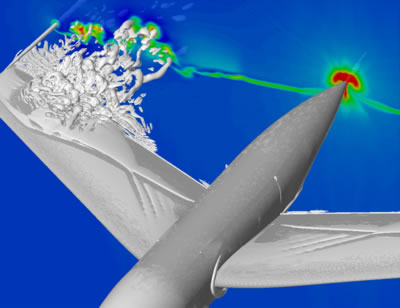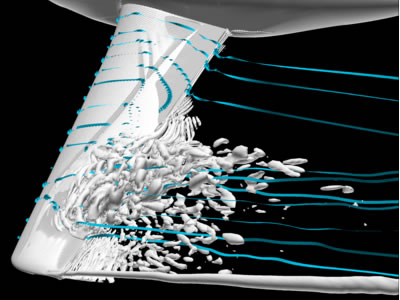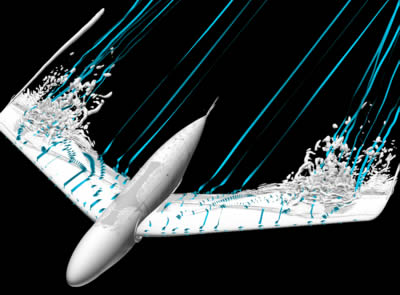Buffeting is a vibration of the aircraft that may appear during maneuvers at cruising speed. Depending on the angle of attack, the flow may contain separations, which constitute an aerodynamic excitation. The aircraft's structure shakes, due to this excitation, and this buffeting may endanger the stability of the flight.

copyright © ONERA 2006 - All rights reserved
Vortices caused in the wake of the aircraft linked to the appearance of buffeting (elsA calculation by Vincent Brunet - DAAP)
To limit this phenomenon and correct the problems of buffeting related to the angle of attack, flaps are placed on the trailing edges of wings: they create a divergence at the lower surface, increasing the rear load, which pushes back the boundary of the buffeting domain - forbidden flight conditions domain.
The Cat3D model was created for an Onera's project, whose subject was the active control of flows. The engineers carried out a test campaign on predicting the "buffeting" phenomenon, using a modern transport aircraft profile with moving flaps on the trailing edges - in order to study the phenomenon for different flap positions.
The work done was taken up again in the framework of the Ananas program: Unsteady Aerodynamics for Aircraft by Navier-Stokes. One of the aims of this program is to create numerical simulation methods (RANS and DES) for predicting buffeting. The RANS (Reynolds Average Navier Stokes) methods are numerical simulation methods that give results averaged over time; with a very restricted spectrum of excitation frequencies. Conversely, the DES (Detached Eddy Simulation) type methods give unsteady results with a much wider spectrum of frequencies.
The Ananas project is continuing with a new approach, by a DES numerical simulation, from which the images on this page have been extracted. These images represent the vortices caused in the aircraft's wake and the current lines initiated on the wing's leading edge. This study will be integrated into Onera's "Bufet'N'Co" project planned for 2007, whose objective is, this time, controlling buffeting and not simply predicting it.
Author: Magali Dodemant, Intern in the Applied Aerodynamics Department (Summer 2006)

Vortices caused in the aircraft's wake and current lines started on the leading edge.

Overall view of the calculation: vortices related to the appearance of buffeting and current lines.




